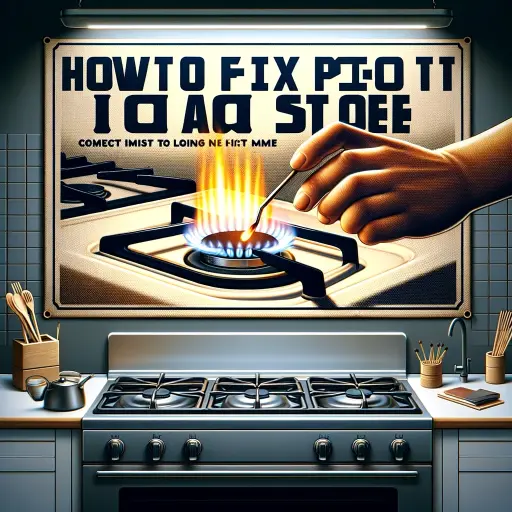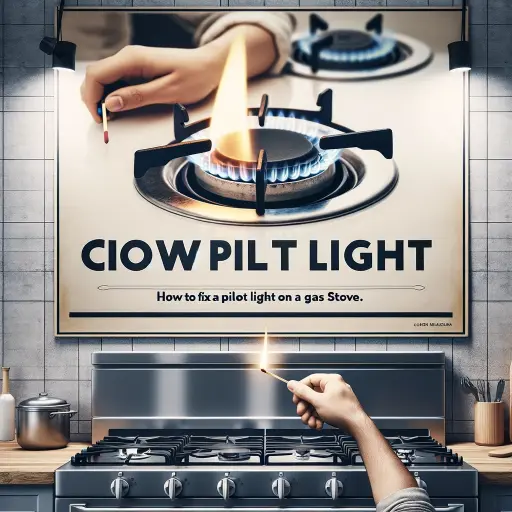How To Fix A Pilot Light On A Gas Stove
Updated: 30 Sep 2023
692

Having a properly functioning pilot light is crucial for the smooth operation of your gas stove. It’s the tiny flame that plays a big role in ensuring your stove works efficiently and safely.
In this guide, we’ll walk you through everything you need to know about fixing a pilot light on your gas stove.
Understanding the Pilot Light and Its Significance

Alright, let’s get started by understanding what this “pilot light” is all about. Picture it as the stove’s dependable little helper – a small, continuous flame that’s always ready to spring into action.
Its job? It’s there to light up the main burners whenever you’re ready to cook up a storm. This little flame is not just a convenience; it’s a vital part of keeping your kitchen safe and your stove efficient.
Common Reasons for Pilot Light Issues
The pilot light issue is one of the common gas stove issues. Here are some common reasons for pilot light issues:

Lack of Proper Maintenance
Do you know how even the most dependable car needs regular oil changes? Well, your pilot light is no different. Neglecting its upkeep can lead to a host of problems.
Dust, dirt, and other debris can accumulate, making it harder for the flame to stay lit. Regular maintenance is like a spa day for your pilot light – it keeps it in tip-top shape.
Faulty Thermocouple
Now, the thermocouple might sound like a character from a sci-fi movie, but it’s actually a crucial component. It’s a safety device that senses whether the pilot light is burning.
If it senses that the flame is out, it shuts off the gas supply to prevent any potential hazards.
Signs of a failing thermocouple? Look out for a pilot light that won’t stay lit, or a gas supply that won’t turn on even when the pilot light is on strike.
How To Fix a Pilot Light on a Gas Stove

Locating the Pilot Light
Alright, time to play detective and find that elusive pilot light. The exact location can vary depending on your stove model, but it’s generally near the burners or stove eyes.
Look for a small, metal tube with a tiny flame at the end. Some stoves have a clear glass window, making it easy to spot. If you’re still unsure, consult your stove’s manual for guidance.
Preparing for Ignition

Before we spark things up, let’s make sure we’re all set:
- Clear the Area: Remove any pans, pots, or obstructions around the burner area. We want a clear path for the flame.
- Check for Debris: Take a quick look around the pilot light. Any dust or dirt can hinder the ignition process, so give it a gentle clean if needed.
- Ensure Proper Ventilation: Double-check that the kitchen is well-ventilated. Fresh air is key to a safe and efficient ignition.
Igniting the Pilot Light
Now, let’s get that flame dancing:
- Use a Long-Reach Lighter: For safety, it’s best to use a long-reach lighter designed for this purpose. If you don’t have one, you can find them at most hardware stores.
- Position the Flame: Hold the flame source near the pilot light. You should hear a gentle ‘whoosh’ as the gas ignites.
- Hold for a Few Seconds: After ignition, keep the flame source steady for about 30 seconds. This ensures the pilot light catches and stays lit.
Confirming a Stable Flame

You’re almost there! Now, let’s make sure everything is okay:
- Observe the Flame: Take a moment to watch the pilot light. It should burn steadily, with a consistent blue flame. If it’s flickering or sputtering, that’s a sign something might be amiss.
- Watch for Any Unusual Behavior: Keep an eye out for any unusual sounds or smells. If anything seems off, it’s better to be safe than sorry. Turn off the gas and seek professional help.
Safety Precautions Before Attempting Repairs

Alright, before we dive into fixing anything, let’s ensure we’re taking all the necessary safety precautions. Safety first, always!
Shutting Off Gas Supply
First things first, let’s make sure we’re in control. Locate the gas supply valve and turn it off. It’s usually a simple knob or lever. This step is crucial to prevent any mishaps.
Ventilating the Area
Now, let’s get some fresh air flowing. Open up windows and doors to ensure proper ventilation. This ensures any lingering gas dissipates safely.
Using Personal Protective Equipment (PPE)
Time to gear up! Put on your safety hat – well, maybe not a literal hat, but safety goggles, gloves, and an apron. These will be your trusty companions as we get to work.
Troubleshooting Common Pilot Light Problems
Pilot Light Keeps Going Out
If your pilot light has a knack for playing hide and seek, here are some potential culprits and how to tackle them:
- Debris Buildup: Dust and dirt can clog the pilot light orifice. Gently clean it with a soft brush or compressed air to ensure a clear path for the flame.
- Faulty Thermocouple: As mentioned earlier, a failing thermocouple might be the culprit. If it’s showing signs of wear or malfunction, it’s best to replace it.
- Improper Gas Pressure: Sometimes, the gas pressure might not be just right. A technician can adjust this for you to ensure a steady flame.
How to relight a pilot light on a furnace?
To relight a pilot light on a furnace, follow these steps:
- Turn off the furnace and wait for a few minutes.
- Locate the pilot light assembly, which usually includes a gas valve with ‘On’, ‘Off’, and ‘Pilot’ settings.
- Turn the valve to ‘Pilot’ and hold down the reset button.
- While holding the button, light the pilot with a long lighter.
- Once the pilot is lit, continue holding the reset button for about a minute to ensure the light stays on.
- Release the button and turn the valve to ‘On’. If the pilot light goes out, repeat the process.
How do you fix the pilot light on a gas oven?
To fix the pilot light on a gas oven:
- Ensure the oven is turned off and cool.
- Open the oven and locate the pilot light, typically at the back of the oven or under the broiler.
- Clean the pilot light area to remove any debris or food residues that might be blocking the gas flow.
- Check if the pilot light port is clogged and clean it carefully with a needle.
- Try relighting the pilot following the manufacturer’s instructions.
- If the pilot doesn’t stay lit, it might be due to a faulty thermocouple or safety valve, which would require professional repair.
Weak or Inconsistent Flame
The Pilot light can be one of the reasons behind the Orange flame color or weak flame. can be due to a few reasons:
- Airflow Obstruction: Check for anything obstructing the airflow around the pilot light. Clear any blockages to allow for a strong flame.
- Gas Supply Issues: Ensure the gas supply valve is fully open. If it’s partially closed, it can lead to a weak flame.
- Thermocouple Positioning: Make sure the thermocouple is properly positioned in the flame. If it’s not, it won’t sense the heat correctly.
Upgrading to an Electronic Ignition System
You can upgrade your gas stove to avoid pilot light issues.
Benefits of Electronic Ignition
Making the switch can be a game-changer for your kitchen. Here’s why:
- Energy Efficiency: Electronic ignition systems use less gas, which means more savings on your energy bills.
- Convenience: No more fumbling for lighters or matches. It’s a hassle-free way to start cooking.
Considerations Before Upgrading
Before you take the plunge, consider these factors:
- Compatibility: Ensure your stove is compatible with an electronic ignition system. Not all models can make the switch.
- Budget: While it’s a worthwhile investment, consider your budget and weigh the long-term benefits.
Commonly Asked Questions on Pilot Light
Why is the pilot light not working on my gas stove?
A failing pilot light can result from various factors, such as a clogged pilot orifice, a malfunctioning thermocouple, or an insufficient gas supply.
How do you turn on a pilot light on a gas stove?
To light a pilot light, first, locate the pilot assembly near the burners. Turn the gas control knob to the “Pilot” position and hold it down. Use a long-reach lighter to ignite the pilot flame. Continue holding the knob down for about 30 seconds to ensure the pilot stays lit.
Is it dangerous if the pilot light goes out?
Yes, it can be dangerous if the pilot light goes out on a gas appliance. When the pilot light is off, gas can still flow and accumulate, creating a risk of gas poisoning or explosion if the gas comes into contact with a spark or flame.
If the pilot light goes out, does gas still flow?
Yes, if the pilot light goes out, there is a risk that gas will continue to flow unless the appliance has a safety feature called a thermocouple.
Final Words
You’ve now got the tools and know-how to keep your gas stove’s pilot light shining bright. Remember, a well-maintained pilot light not only ensures a safe kitchen but also keeps your stove running efficiently.
Apply these tips for a kitchen that’s both safe and efficient. Happy cooking!
Please Write Your Comments